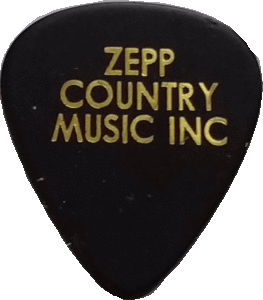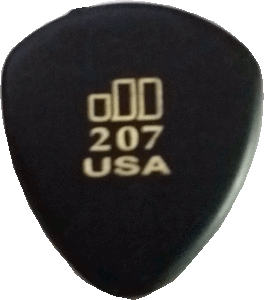Okay. Outside of my entomological writings, this is probably the most esoteric, arcane, and boring topic I’ve ever felt obliged to document: my personal flatpick selection.
Now, first off, let’s explain what a “flatpick” is: it’s the thing everyone thinks of when someone says “guitar pick.” Here’s the shape most people probably think of, but picks are available in all sorts of sizes, thicknesses, shapes, colors, and materials.
(See what I did there?) Many of those variables are simply a matter of personal preference, and a discussion of each of them in detail is grist for another mill, so let’s just say that a pick’s material and flexibility can have a huge impact on an instrument’s tone.
For many decades, I had used a pick of the size and shape shown above: in particular, one made by the Dunlop Manufacturing Company of Delrin brand of polyoxymethylene thermoplastic, and being 1.14mm (0.045 inches) thick. I had settled on this pick because I liked the tone it drew from my go-to guitar, a 1965 Martin D-35.
However, I opened an acoustic stringed instrument music store in 1998, and suddenly had a nearly infinite array of picks available, comprising all the possible variables. In fact, at the time, I still had quite a collection of 20-30 picks made of tortoise shell, which had been legally sold in the 1960s, during which time I coincidentally worked in a music store and had bought a bunch. Genuine shell picks, you know, became the Holy Grail of picks when their sale and trade were appropriately–if belatedly–banned by CITES.
So, one day my then-teenaged son Alex and I set out to find which pick suited me best. I had already decided that there were many I just don’t like (great big triangles, tiny little picks, super thin, nylon, stone, metal, etc.) and had narrowed it down to a selection of 20-some-odd picks that I sort of liked, including a genuine tortoise shell pick and some other very expensive, boutique picks.
We then prepared a grid, and did a paired comparison test, for which I was given 2 picks at a time to compare by playing my D-35 (with my eyes closed the whole time). The only criterion was which of the two produced tone that I liked better.
My son and another person who was there (sorry, I don’t remember who that was) knew what picks I was trying, of course, and they not only wrote down my preferences, but each of them also privately indicated which tone he preferred in each pairing. There was no discussion at all. To further explain the process, but using only 5 items for brevity, a grid such as this would used:
| Pick 1 | Pick 2 | Pick 3 | Pick 4 | Pick 5 | |
| Pick 1 | – | – | – | – | – |
| Pick 2 | 1 | – | – | – | – |
| Pick 3 | 4 | 3 | – | – | – |
| Pick 4 | 1 | 4 | 4 | – | – |
| Pick 5 | 1 | 2 | 3 | 4 | – |
| Times Won | |||||
| Pick 1 | 3 | ||||
| Pick 2 | 1 | ||||
| Pick 3 | 2 | ||||
| Pick 4 | 4 | ||||
| Pick 5 | 0 |
Where each item is compared head-to-head with each other item, and the “winner” noted at their intersection. Clearly, in this example grid “item 4” was preferred over every other pick, while pick “1” beat all the others except “4”, etc.
So, among the 20 or so picks I compared, the overall “winner” (also selected by the two listening “witnesses”!) was…a Dunlop brand 2.03mm (0.084 inch) thick, Delrin pick marketed as a “JAZZTONES 207.”

I still use these picks, despite having tried numerous–as well as some very expensive–other picks over the years. Oh, and before you ask: I gave all those tortoise shell picks (which had ranked around 5th, as I recall) to a friend who was convinced their being “forbidden fruit” had made them the only picks to use.